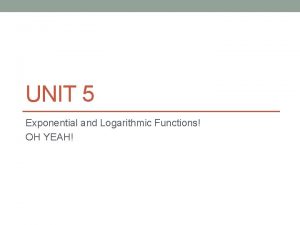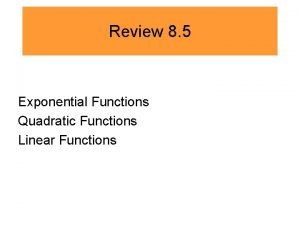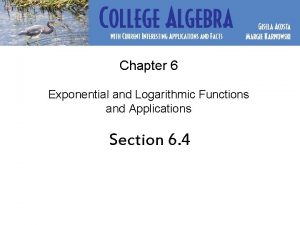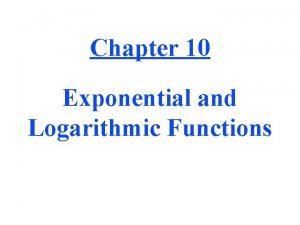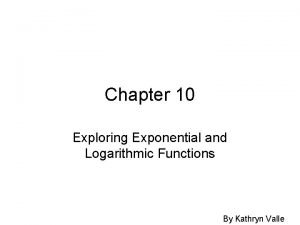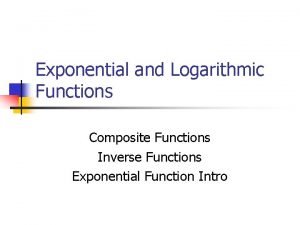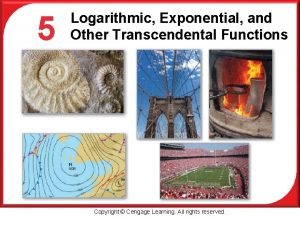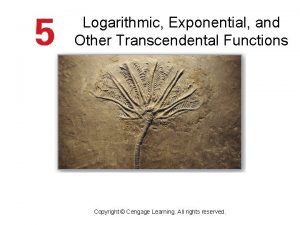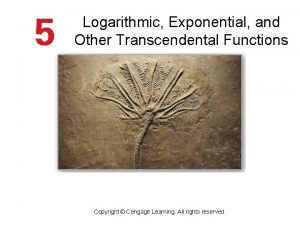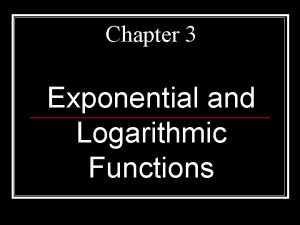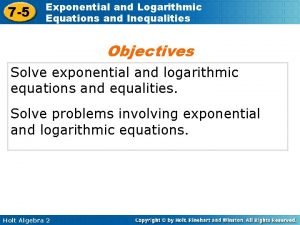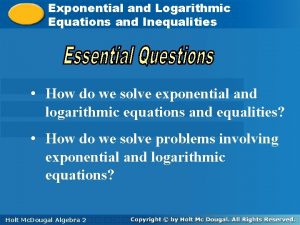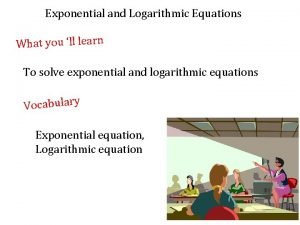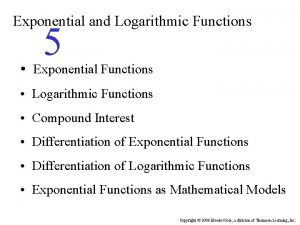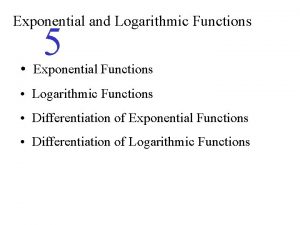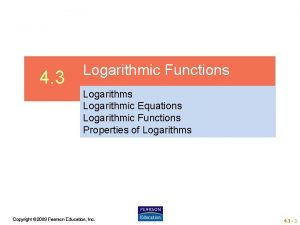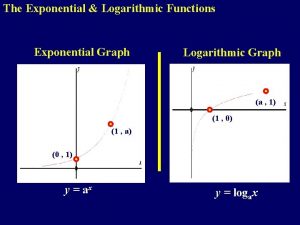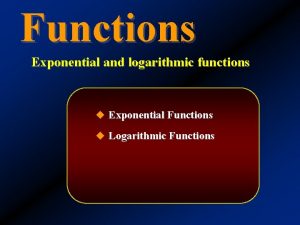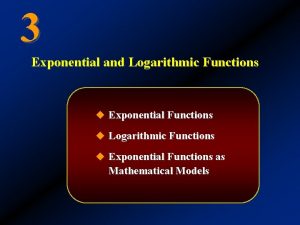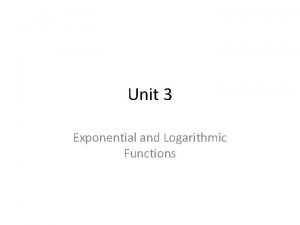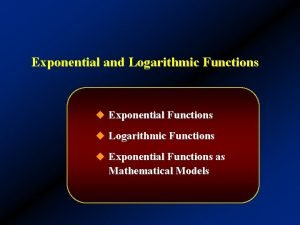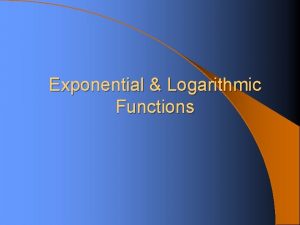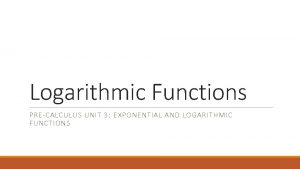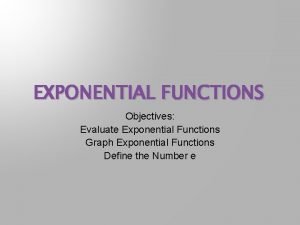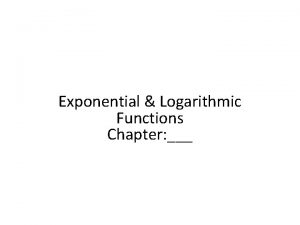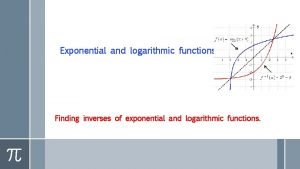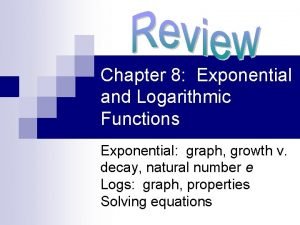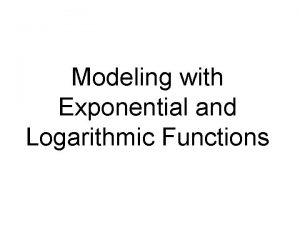Exponential and Logarithmic Functions Section 4 2 Exponential


























- Slides: 26

Exponential and Logarithmic Functions Section 4. 2 Exponential Functions

Concepts 1. Graph Exponential Functions 2. Evaluate the Exponential Function Base e 3. Use Exponential Functions to Compute Compound Interest 4. Use Exponential Functions in Applications

Graph Exponential Functions Previously: Now:

Graph Exponential Functions Exponential Function: Let b be a constant real number such that b > 0 and b ≠ 1. Then for any real number x, a function of the form is called an exponential function of base b.

Example 1: Graph the function.

Example 2: Graph the function.


Example 3: Graph the function.

Example 3 continued: If h > 0, shift to the right. If h < 0, shift to the left. Parent function: If a < 0 reflect across the x-axis. Shrink vertically if 0 < |a| < 1. Stretch vertically if |a| > 1. If k > 0, shift upward. If k < 0, shift downward.


Concepts 1. Graph Exponential Functions 2. Evaluate the Exponential Function Base e 3. Use Exponential Functions to Compute Compound Interest 4. Use Exponential Functions in Applications

Evaluate the Exponential Function Base e e is a universal constant (like the number ) and an irrational number. e ≈ 2. 71828

Examples 4 – 7: Evaluate. Round to 4 decimal places. 4. 5. 6. 7.

Example 8: Graph the function.


Concepts 1. Graph Exponential Functions 2. Evaluate the Exponential Function Base e 3. Use Exponential Functions to Compute Compound Interest 4. Use Exponential Functions in Applications

Use Exponential Functions to Compute Compound Interest Suppose that P dollars in principle is invested (or borrowed) at an annual interest rate r for t years. Then: Amount of simple interest I (in $) Amount A (in $) in the account after t years and n compounding periods per year. Amount A (in $) in the account after t years under continuous compounding.

Example 9: Suppose that $15, 000 is invested with 2. 5% interest under the following compounding options. Determine the amount in the account at the end of 7 years for each option. a) Compounded annually

Example 9 continued: b) Compounded quarterly c) Compounded continuously


Concepts 1. Graph Exponential Functions 2. Evaluate the Exponential Function Base e 3. Use Exponential Functions to Compute Compound Interest 4. Use Exponential Functions in Applications

Example 10: Weapon-grade plutonium is composed of approximately 93% plutonium-239 (Pu-239). The half-life of Pu-239 is 24, 000 years. In a sample originally containing 0. 5 kilograms, the amount left after t years is given by Evaluate the function for the given values of t and interpret the meaning in context.

Example 10 continued: a) b)

Example 11: A 2010 estimate of the population of Mexico is 111 million people with a projected growth rate of 0. 994% per year. At this rate, the population P(t) (in millions) can be approximated by where t is the time in years since 2010.

Example 11 continued:

 Unit 8 exponential and logarithmic functions
Unit 8 exponential and logarithmic functions Examples of exponential equations
Examples of exponential equations How to tell if an equation is linear or quadratic
How to tell if an equation is linear or quadratic Chapter 6 exponential and logarithmic functions answers
Chapter 6 exponential and logarithmic functions answers Chapter 4 exponential and logarithmic functions
Chapter 4 exponential and logarithmic functions Chapter 4 exponential and logarithmic functions answer key
Chapter 4 exponential and logarithmic functions answer key Lesson 10-2 exponential growth and decay
Lesson 10-2 exponential growth and decay Property of equality for exponential functions
Property of equality for exponential functions Transforming exponential and logarithmic functions
Transforming exponential and logarithmic functions Composite exponential function
Composite exponential function Chapter 5 exponential and logarithmic functions
Chapter 5 exponential and logarithmic functions Expanding natural logarithms
Expanding natural logarithms Chapter 9 exponential and logarithmic functions answer key
Chapter 9 exponential and logarithmic functions answer key Chapter 9 exponential and logarithmic functions answer key
Chapter 9 exponential and logarithmic functions answer key Chapter 5 exponential and logarithmic functions answer key
Chapter 5 exponential and logarithmic functions answer key Horizontal line test inverse
Horizontal line test inverse Solving exponential and logarithmic functions calculator
Solving exponential and logarithmic functions calculator Logarithmic exponential and other transcendental functions
Logarithmic exponential and other transcendental functions Logarithmic exponential and other transcendental functions
Logarithmic exponential and other transcendental functions Chapter 5 exponential and logarithmic functions
Chapter 5 exponential and logarithmic functions Chapter 3 exponential and logarithmic functions
Chapter 3 exponential and logarithmic functions Log to exponential
Log to exponential Exponential and logarithmic equations and inequalities
Exponential and logarithmic equations and inequalities 3-4 exponential and logarithmic equations
3-4 exponential and logarithmic equations Exponential equation example
Exponential equation example Exponential and logarithmic equations and inequalities
Exponential and logarithmic equations and inequalities Modeling with exponential and logarithmic equations quiz
Modeling with exponential and logarithmic equations quiz

